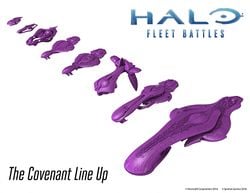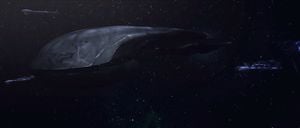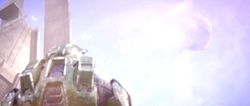Covenant fleet
From Halopedia, the Halo wiki
| This article does not meet the wiki's general standards and/or standards on layouts. You can help by cleaning this article. |
| This article does not have enough inline citations and/or does not adhere to the proper citation format. You can help Halopedia by adding citations. |
The Covenant fleet is a general term for the vast space-borne naval components of the Covenant's military forces.[1][2] Their roles included ship-to-ship combat, orbital bombardment, the deployment of fighters and bombers and the method of delivery for the Covenant's occupational ground forces. At its height, the Covenant fielded thousands of warships, most being able to carry fighters, dropships, ground troops and vehicles; after the Human-Covenant War, most of these fell under the control of the various Covenant remnants. Each Covenant fleet unit is essentially a fully-rounded armada, and is given a unique name with religious connotations similar to how Covenant vessels and colony worlds are named by their beliefs.
Although the Covenant's collective naval forces are referenced in some contexts as the Covenant Navy,[3][4] the Covenant did not maintain distinct service branches in the same manner as the United Nations Space Command and traditional human militaries; instead, the Covenant fleets fell under the authority of various ministerial organizations.[5]
History
Great Schism
Throughout the majority of the Covenant civil conflict known as the Great Schism, the Covenant military was violently splintered between those who continued to believe in the Prophets' wisdom and those who followed Arbiter Thel 'Vadam and opposed the Prophets' rule. As the battle raged, the High Prophet of Truth formally transferred command of the navy to the Jiralhanae, a position once exclusively held by the Sangheili. The Sangheili wiped out the majority of the Covenant fleet at the Battle of Installation 00.
Soon after the outbreak of the Schism, Sangheili numbers were reduced by a pair of disasters. At Joyous Exultation, the massive Combined Fleet of Righteous Purpose, headed by Imperial Admiral Xytan 'Jar Wattinree aboard the supercarrier Sublime Transcendence, was consumed by a NOVA bomb. At Onyx, a battle group headed by the cruiser Incorruptible was destroyed by the Forerunner Sentinels that comprised the artificial planet.
Due to this disarray, the only Sangheili fleet to fight in the last battles of the war was the Fleet of Retribution, which was led by the assault carrier Shadow of Intent. During the battles of Voi and the Ark the Jiralhanae-led loyalist fleet was mostly limited to Truth's fleet, which outnumbered the Sangheili three to one by the time of the Battle of Installation 00. This fleet contained a number of battlecruisers and assault carriers, led by Truth's Forerunner Dreadnought.
Organization
Despite the seemingly monolithic nature of its armed forces, the Covenant does not maintain a single standing navy. Instead, its fleets are partitioned between several ministries, expanding and contracting as their parent ministry's influence waxes and wanes in prestige and influence, of which the most notable were the Ministry of Resolution, the Ministry of Fervent Intercession, and the Ministry of Tranquility.[6]
Fleets under the Ministry of Resolution were originally tasked with patrolling Covenant space, protecting shipping and eradicating pirates, but was vastly expanded during the early stages of the Human-Covenant War to serve as deep-space exploration units beyond the fringe, protection for Ministry of Tranquility missionary ships, and front-line units in the conquest and destruction of humanity.[7] As the war with humanity wore on, the Covenant were forced to transfer patrol units to front-line fleets to replace combat losses, hoping to hide the damage humanity was managing to inflict from Sangheili leaders. Being posted to a fleet under the Ministry of Resolution was considered honorable, due to being removed from normal society for extended periods.[6]
Fleets under the Ministry of Fervent Intercession were tasked with locating and securing Forerunner worlds and artifacts, and possessed enough zealots that it was considered a semi-monastic order. Fervent Intercession fleets tended to be smaller, but acted largely independently of any external chain of command except where it served their purposes, but were able to call upon the resources of other fleets, and even directly from the colonies, due to ancient writs that dated back to the formation of the Covenant. Fleets under the Ministry of Fervent Intercession had a formidable reputation even among the Covenant, and were largely used to seize and defend Forerunner sites on human colonies during the war.[6]
Fleets under the Ministry of Tranquility were, ostensibly, tasked with finding Forerunner artifacts and bringing new species into the Covenant fold. In practice, however, they functioned as little more than pirates, frequently picking off relics held by other Covenant fleets, and their so-called missionary ships were often merely slavers and raiders crewed largely by Kig-Yar. Not beholden even to the High Prophets, of whom the Prophet of Regret himself was the former Vice-Minister of Tranquility, these units rarely served as combat units during the Covenant conquest of human colonies, but would arrive to steal whatever relics had been secured from human defenders or their Covenant "allies" in the chaotic aftermath.[6]
Other Covenant ministries are known to have their own forces, though not in such great numbers. In 850 BCE the Ministry of Anticipatory Security sent forces to secure Forerunner relics on Janjur Qom, and escort female San'Shyuum volunteers to High Charity. The disastrous mission led to the ministry's total dissolution, and the punishment of the Minister involved.[8] In 2525, The Ministry of Conversion was technically the only body authorized to send ships to make contact with possible convertees, though this was routinely ignored by the Ministry of Tranquility. The Ministry of Preservation was specifically mandated with putting down local uprisings and secession attempts by the client races, and its forces were led by future Arbiter Ripa 'Moramee before 2531.[9] In 2552, Thon 'Talamee, shipmaster of the Clarity of Faith, escorted Covenant supply convoys under the Ministry of Fortitude, a ministry ostensibly tasked with ensuring the proper distribution of Forerunner relics across the Covenant.[10] The Ministry of Abnegation held authority over the Sangheili Ascetic orders,[11] and the Ministers of Inquisition and Etiology both served in Covenant fleets with some considerable authority.[12][13]
The largest known fleets have been known to consist of around one hundred starships of all types and variations,[14] and are led by a prominent flagship, which is often an assault carrier or in rare cases a supercarrier. Capital ships, such as the iconic CCS-class battlecruisers, as well as numerous frigates and destroyers, usually serve as escorts to the flagship. Fleets are sustained by numerous logistics vessels, such as agricultural support ships, which are organizationally attached to warship fleets, providing food and supplies.[15] Covenant fleets were divided into tactical battle group formations that were used in specialized roles.[16]
A number of combat legions are often attached to a given Covenant fleet, stationed aboard the various warships available.[17]
The title of a Covenant fleet's commander varies depending on the size and extension of the fleet itself. While smaller fleets or temporary task forces are led by Fleet Masters, larger fleets are commanded by Supreme Commanders. There are also cases where an individual with the title of Shipmaster has had command of a fleet.[18][19] A fleet's highest-ranking individuals convene in a group known as Council of Masters.[20] In some cases, a Minor Prophet or a San'Shyuum High Councilor is attached to a fleet as a representative of the High Council.[21]
Combined fleets
A combined fleet, as its name implies, is comprised of multiple smaller fleets and is led by a Supreme Commander, or, if of sufficient size, an Imperial Admiral. These fleets have larger duties, such as safeguarding and policing entire regions of Covenant-controlled space on their own. These fleets can have several hundred ships. High Charity was guarded by a combined fleet at all times. Some combined fleets are formed on a strictly temporary, task-oriented basis, such as a major invasion of a key enemy system.
Known fleets
By the time of the Fall of Reach, the Office of Naval Intelligence knew of at least four Covenant fleets of similar size to the Fleet of Particular Justice prowling the human sphere, though the specific names and organisation of these elements is unknown.[22]
| |||||||||||||
Known vessels

Space stations
- High Charity - The Covenant holy city and site of government; absorbed by the Flood, crashed onto Installation 00 and reactor destroyed by Spartan John-117. Its ruins are contained by Sentinels.
- Unyielding Hierophant - Destroyed by Spartan Blue Team, led by John-117.
Carriers
DDS-class carrier
- Ascendant Justice - Captured by UNSC, destroyed during Operation: FIRST STRIKE in 2552. Slipspace drive was refitted to UNSC Gettysburg.
CAS-class assault carrier
- Enduring Conviction - Destroyed over Installation 00 by Aggressor Sentinels in 2559.
- Resplendent Fervor - Unknown status. Aft section scuttled during Operation: WARM BLANKET by Supreme Commander Luro 'Taralumee.
- Seeker of Truth - Unknown status
- Shadow of Intent - Returned to Sanghelios after ceasefire in March 2553
- Solemn Penance - Unknown status
- Clarity of Faith - Crash-landed on an unidentified moon in August 2552
- Song of Retribution – Unknown status
- Day of Jubilation – Destroyed at the beginning of Battle for Earth by an antimatter charge delivered by Spartan John-117.
- Breath of Annihilation – In the control of Sali 'Nyon's Covenant faction.
- Eternal Reward - Destroyed in the beginning of Great Schism by the Jiralhanae fleet.
CSO-class supercarrier
- Long Night of Solace - Destroyed over Reach on Operation: UPPER CUT.
- Sublime Transcendence - Destroyed after taking a NOVA Bomb onboard and the crew accidentally activating it.*
Unknown class
- Lawgiver - Unknown status, possibly destroyed
Cruisers
ORS-class heavy cruiser
- Blight of the Profane - Unknown status
- Incorruptible - Destroyed in the Onyx Conflict
CCS-class battlecruiser
- Triumphant Declaration - Unknown status
- Harbinger of Piety - Destroyed by a MAC shot from Nassau Station.
- Indulgence of Conviction - Commandeered by Flood, destroyed in the Battle of Voi by Fleet of Retribution for Flood containment.
- Pious Inquisitor - Destroyed in the Skirmish on Pious Inquisitor
- Purity of Spirit - Unknown status
- Sacred Promise (hypothesized) - Unknown status, presumably destroyed.
- Sanctity of Purification - Destroyed in the Battle of Fumirole.
- Truth and Reconciliation - Destroyed during the Battle of Installation 04 in its third raid by Lieutenant McKay.
- CCS-U624 - Unknown status
- CCS-U321 - Destroyed in the Battle of Arcadia
CRS-class light cruiser
- Spear of Light - Captured by the Swords of Sanghelios from Tem'Bhetek.
Unknown classes
- Infinite Sacrifice - Unknown status
- Rapid Conversion - Unknown status
- Unidentified cruiser (Particular Justice) - Destroyed in the Fall of Reach by the Alpha division of Red Team.
- Unrelenting - Destroyed in the Battle of Chi Ceti
Destroyers
CPV-class heavy destroyer
- Bloodied Spirit - Destroyed during the Onyx Conflict.
- Esteem - Unknown status
- Reverence - Destroyed
- Radiant Perception - Destroyed during the Battle for Arcadia.
- Proclamation's Tithe - Status unknown
Unknown class
- Absolution - Destroyed during the Onyx Conflict
- Far Sight Lost - Destroyed during the Onyx Conflict
- Rapturous Arc - Captured by the Flood and subsequently destroyed by combined Sangheili and Jiralhanae forces at the beginning of the Great Schism
- Retribution's Thunder - Scuttled by its Kig-Yar crew during Battle of the Rubble.
Frigates
Frigates
- Tenebrous - Destroyed by the Incorruptible during the Battle of Installation 05.
- Twilight Compunction - Destroyed during the Battle of Installation 00.
- Revenant - Destroyed by the Incorruptible during the Onyx conflict.
- Unflinching Resolve - Decommissioned, later reinstated by Servants of the Abiding Truth and destroyed in March 2553.
CAR-class frigate
- Contrition - Unknown status
- Penance - Unknown status
Corvettes
SDV-class heavy corvette
- Ardent Prayer - Captured by the UNSC, used as transportation for a Shaw-Fujikawa Translight Engine makeshift bomb and destroyed in Operation: UPPER CUT by Spartan Jorge-052.
- Elegy's Lament - Stolen by the Banished
- Quester of Glory - Fell into Sangheili control during the Great Schism; renamed Mayhem. Crippled and salvaged by UNSC Witness in Operation: FAR STORM.
- Supplication of Purity - Destroyed in the Battle for Tribute in 2552, later salvaged and displayed at Outpost Discovery.
DAV-class light corvette
- Infinite Fire - Fell into Sangheili control during the Great Schism; renamed The Lookout
Unknown class
- Vengeful Vitality - A stealth corvette used by Mken 'Scre'ah'ben.
- Adherent - Unknown status, crew massacred by the Silent Shadow.
Support ships
DSC-class support ship
- Infinite Succor - Destroyed, sent into a star to prevent the Flood from escaping by Rtas 'Vadum.
Hudal-class auxiliary vessel
Unknown class
- A Psalm Every Day - Unknown status
- Commitment and Patience - Destroyed
- Devotion - Destroyed
- Infinite Spoils - Unknown status
- Minor Transgression - Destroyed.
- Paragon - Unknown status
- Pitiless - Unknown status
- Serene Certainty - Unknown status
- Unrelenting - Destroyed in the Battle of Chi Ceti by Blue Team.
- Unwavering Discipline - Destroyed
- Valorous Salvation - Unknown status
Important personnel
- Imperial Admiral Xytan 'Jar Wattinree
- Supreme Commander Thel 'Vadamee (current Arbiter)
- Supreme Commander Luro 'Taralumee
- Supreme Commander Rho 'Barutamee
- Fleet Master Voro Nar 'Mantakree
- Shipmaster Rtas 'Vadum
- Shipmaster Orna 'Fulsamee
- Shipmaster Jul 'Mdamaee
- Unidentified Shipmaster (Righteous Vigilance)
List of appearances
Sources
- ^ Halo: Contact Harvest, page 226
- ^ Halo: The Great Journey: The Art of Building Worlds, page 72
- ^ Bungie.net: The Tru7h About Co-Op in Halo 3
- ^ Spartan Games: Halo Busts Now Shipping
- ^ See Covenant military#Organization
- ^ a b c d Halo: Fleet Battles, Core Rule Book p. 7
- ^ Halo: The Essential Visual Guide, pages 10, 11, 175
- ^ Halo: Broken Circle
- ^ Halo: The Essential Visual Guide, page 10
- ^ Halo: Blood Line, Issue 1
- ^ Halo: The Essential Visual Guide, page 56
- ^ Halo: Uprising, Issue 4
- ^ Halo Graphic Novel, The Last Voyage of the Infinite Succor
- ^ Halo: Ghosts of Onyx, page 195
- ^ Halo Graphic Novel, "The Last Voyage of the Infinite Succor"
- ^ Halo: Fleet Battles, Core Rulebook - pages 120-121
- ^ Halo: Ghosts of Onyx, page 350
- ^ Halo: Evolutions - Essential Tales of the Halo Universe, "The Return"
- ^ Halo 3
- ^ Halo: The Flood, page 150
- ^ Halo: Evolutions, "The Return", page 497
- ^ Bungie.net, Jason Jones Interviewed By You (Archive)

